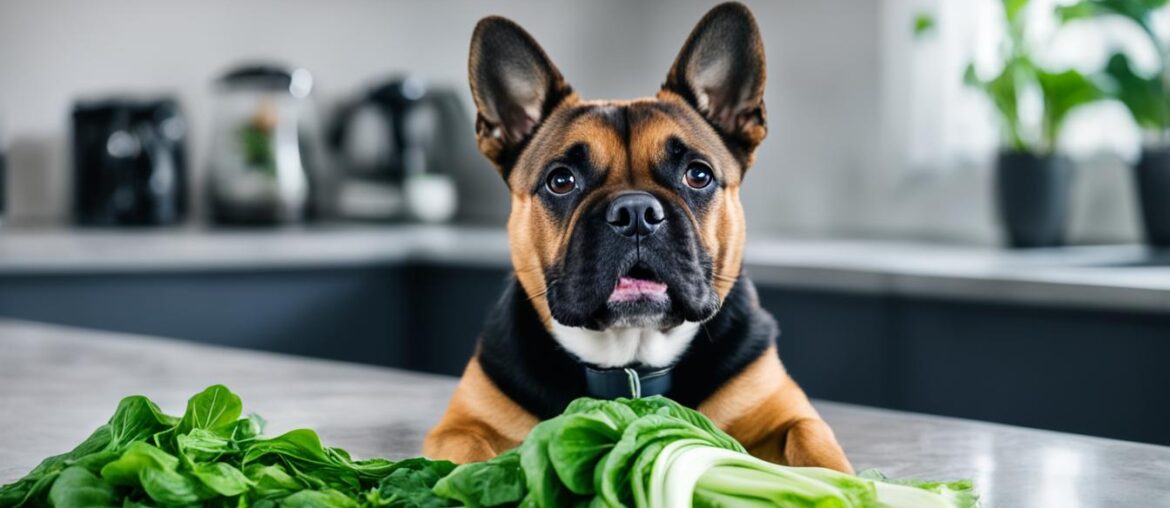As a responsible dog owner, you always want to ensure that your furry friend is eating a safe and healthy diet. When it comes to introducing new foods, it’s important to understand the potential benefits and risks. In this article, I will explain whether bok choy, a popular leafy green vegetable, is safe for dogs to eat.
Bok choy is not only safe for dogs to consume but can also provide a range of health benefits. This vegetable is low in calories and fat, making it an ideal addition to a dog’s diet, especially for those looking to maintain a healthy weight. Bok choy is packed with essential vitamins such as A, C, and K, as well as minerals like potassium and calcium.
However, it’s crucial to introduce bok choy gradually and monitor your dog for any adverse reactions. While many dogs tolerate bok choy well, some may experience gastrointestinal upset or gas. As with any new food, consulting with your veterinarian is recommended to ensure the safety and suitability of bok choy for your specific dog.
Key Takeaways:
- Bok choy is safe for dogs to eat in moderation.
- It is a low-calorie and low-fat vegetable, suitable for dogs trying to maintain a healthy weight.
- Bok choy is rich in vitamins A, C, and K, as well as minerals like potassium and calcium.
- Introduce bok choy gradually and monitor your dog for any adverse reactions.
- Consult with your veterinarian before incorporating bok choy into your dog’s diet.
Leafy Greens that Dogs Can Eat
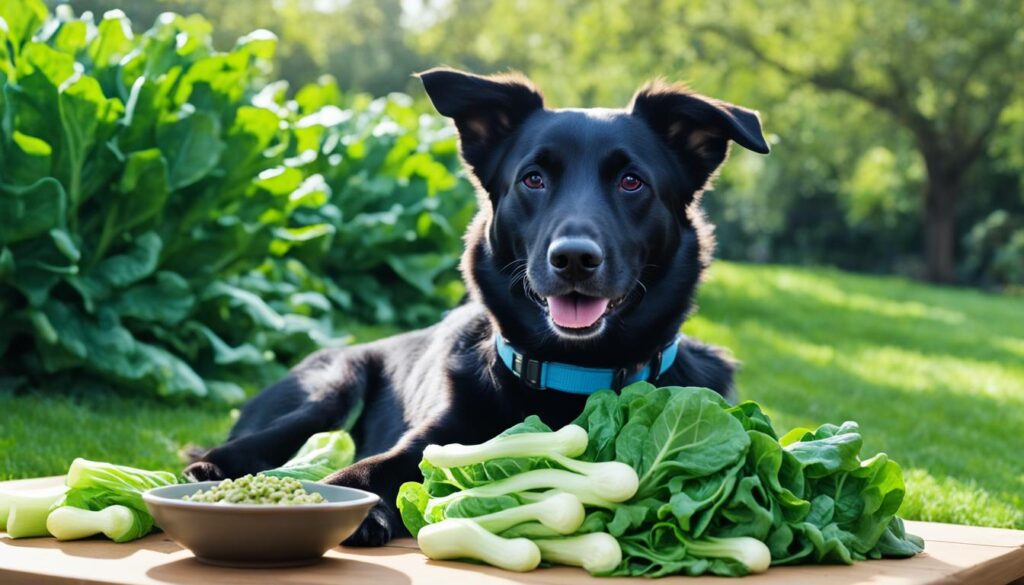
In addition to bok choy, there are other dog-friendly leafy greens that can be safely incorporated into a dog’s diet. These greens provide a host of beneficial nutrients, including vitamins A, C, and K, as well as fiber.
Lettuce: Lettuce is a low-calorie option and can provide hydration due to its high water content.
Spinach: Spinach is packed with vitamins and minerals, including iron, which is essential for oxygen transport.
Chard: Chard is rich in antioxidants and can support a healthy immune system.
Cabbage: Cabbage is a good source of vitamins, minerals, and dietary fiber, promoting digestive health.
Kale: Kale is a nutrient powerhouse, containing vitamins, minerals, and antioxidants that can support overall health.
It is important to feed these leafy greens to dogs in their raw form to ensure they receive the maximum nutritional benefits. However, some dogs may have difficulty digesting raw greens. In such cases, steaming or baking the greens can make them easier to digest. It is crucial to introduce leafy greens slowly and in small quantities to avoid potential digestive issues.
Remember, consulting with a veterinarian before incorporating any new foods into your dog’s diet is always recommended. They can provide personalized guidance based on your dog’s specific needs and health conditions.
Safe Root Vegetables for Dogs
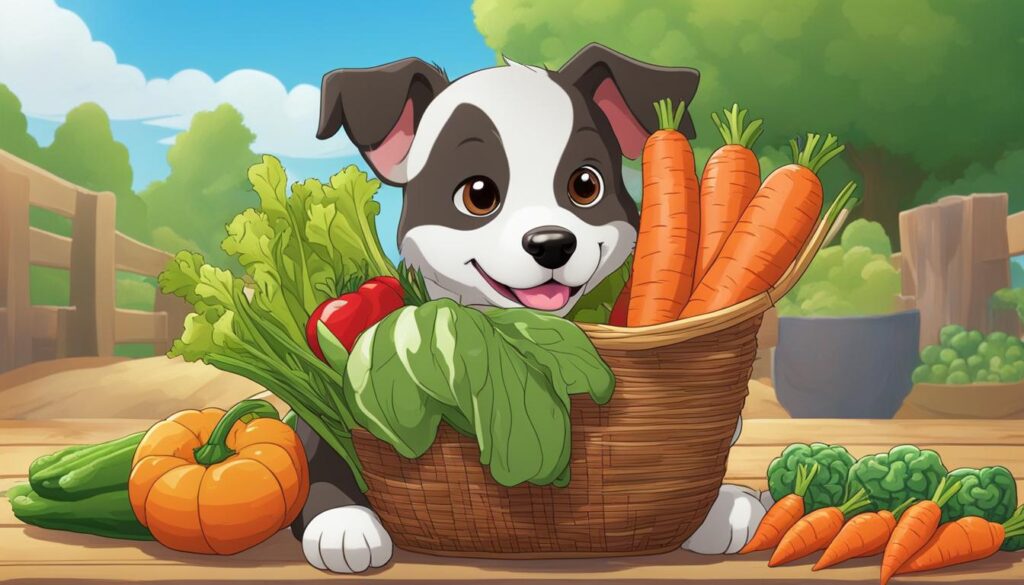
When it comes to incorporating vegetables into a dog’s diet, root vegetables are a great option. Not only are they safe for dogs to consume, but they also provide a wide range of essential nutrients, including vitamins and minerals. When choosing root vegetables for your furry friend, consider options such as carrots, beets, sweet potatoes, and parsnips.
Carrots are a popular choice, packed with vitamin A and fiber, promoting healthy vision and digestion. Beets, on the other hand, are rich in antioxidants and can help support your dog’s immune system. Sweet potatoes are a great source of vitamin C and beta-carotene, which can help maintain healthy skin and coat. Finally, parsnips offer a good dose of dietary fiber.
However, it’s important to feed root vegetables to dogs in moderation. As these vegetables contain starch and natural sugars, excessive consumption can lead to weight gain and other health issues. Additionally, some commercial dog foods already include root vegetables in their formulas, so it’s essential to consider the overall balance of your dog’s diet.
If you’re unsure about how to incorporate root vegetables into your dog’s meals, consult with your veterinarian. They can provide personalized guidance based on your dog’s specific needs and dietary requirements.
Benefits of Root Vegetables for Dogs:
- Rich in essential vitamins and minerals.
- Provide dietary fiber for digestive health.
- Support a strong immune system.
- Promote healthy skin and coat.
By including root vegetables in your dog’s diet, you can provide them with a variety of nutrients that contribute to their overall well-being. However, remember to feed these vegetables in moderation and seek guidance from a veterinary professional.
Stalk Vegetables Safe for Dogs
When it comes to feeding your furry friend, stalk vegetables like celery and asparagus can be a healthy addition to their diet. Although some dogs may not find these vegetables particularly appealing, they are safe for consumption and can provide additional fiber and nutrients. To ensure that your dog can enjoy the benefits of these stalky vegetables, consider the following:
Cut or Steam for Easy Chewing and Digestion
Slicing stalk vegetables into small, bite-sized pieces can make them easier for dogs to chew and digest. Alternatively, steaming the vegetables can also soften them, making them more palatable and easier to digest.
By incorporating stalk vegetables into your dog’s diet, you can help diversify their nutrition and provide essential fiber for a healthy digestive system. Remember to introduce any new food gradually and in moderation, monitoring your furry friend’s response and adjusting as necessary. Consulting with your veterinarian is always a good idea to ensure that your dog’s dietary needs are being met.
Can Dogs Eat Squash?
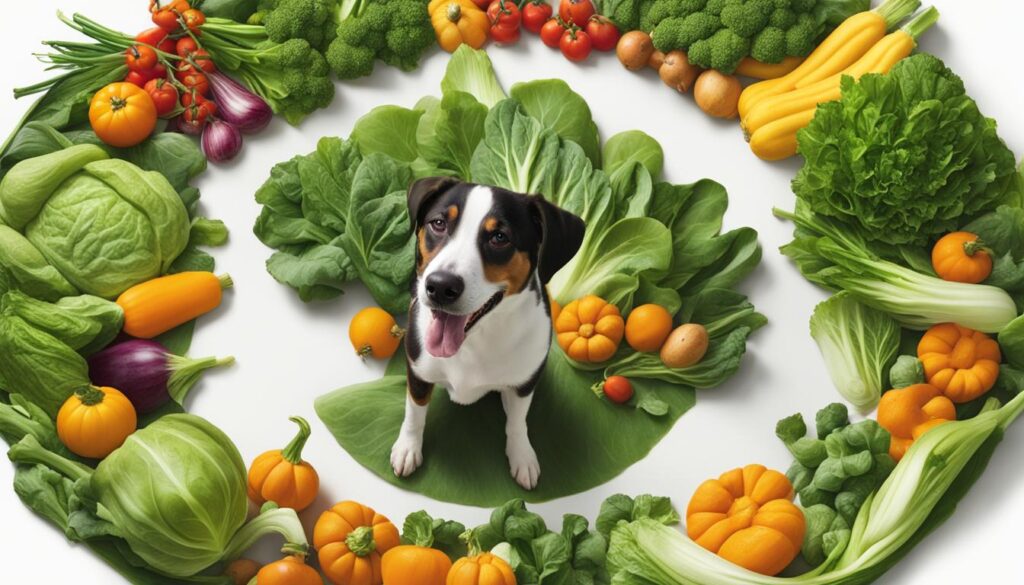
Squash, including pumpkin and butternut squash, is safe for dogs to eat. These vegetables can be beneficial for dogs with digestive issues, as they can help alleviate bouts of diarrhea. It is important to remove the seeds and skin of the squash before feeding it to dogs, as these parts can pose a choking hazard. Squash is also rich in nutrients and low in calories, making it a healthy addition to a dog’s diet.
When feeding squash to dogs, it is important to prepare it properly. Here is a step-by-step guide:
- Choose a ripe squash. The skin should be firm and free from any signs of mold or decay.
- Wash the squash thoroughly to remove any dirt or pesticides.
- Cut the squash in half lengthwise and scoop out the seeds and stringy pulp. These parts can be difficult for dogs to digest and may cause choking.
- Peel the skin off the squash using a vegetable peeler or a knife. The skin can be tough and can also pose a choking hazard.
- Cut the squash into small, bite-sized pieces that are appropriate for your dog’s size.
- Steam or boil the squash until it is tender. This will make it easier for dogs to chew and digest.
- Allow the squash to cool before serving it to your dog.
Remember, moderation is key when feeding squash to dogs. It is always best to consult with your veterinarian before making any changes to your dog’s diet, including adding squash or any other vegetables.
Benefits of Feeding Squash to Dogs
Feeding squash to dogs can provide several benefits due to its nutritional content. Here are some key nutrients found in squash:
| Nutrient | Health Benefits |
|---|---|
| Vitamin A | Supports healthy vision, immune function, and cell growth. |
| Vitamin C | Boosts the immune system and helps prevent cell damage. |
| Fiber | Promotes healthy digestion and bowel movement. |
| Potassium | Assists in maintaining healthy heart function, nerve function, and muscle contractions. |
| Manganese | Supports bone health and contributes to energy metabolism. |
By incorporating squash into your dog’s diet, you can provide them with these essential nutrients that contribute to their overall health and well-being.
Legumes that Dogs Can Eat
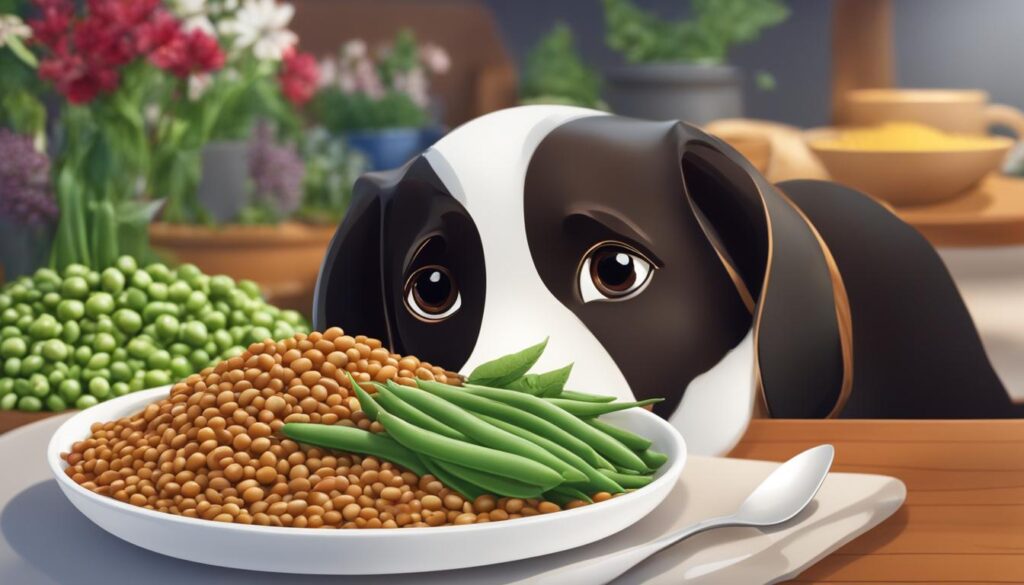
When it comes to incorporating vegetables into a dog’s diet, legumes can be a viable option. Legumes, including beans and peas, can provide dogs with essential nutrients and fiber. However, it is important to exercise caution and moderation when feeding legumes to our furry friends.
Recent reports have linked diets high in legumes to canine dilated cardiomyopathy (DCM), a heart condition that can be life-threatening for dogs. Therefore, it is recommended to avoid feeding excessive amounts of legumes to dogs, especially if their main diet already contains legumes. It’s important to strike a balance between incorporating legumes into a dog’s diet and safeguarding their overall health.
In particular, green beans can be a dog-friendly legume option. They are often categorized as legumes and can be fed to dogs in moderation. Green beans provide a crunchy texture that dogs enjoy, along with ease of digestion. They can be a healthy addition to a dog’s diet, offering substantial fiber, vitamins, and minerals.
When feeding legumes to your dog, it is important to introduce them gradually and monitor their response. Watch for any signs of digestive upset or allergic reactions. If you have concerns or questions about incorporating legumes into your dog’s diet, consult with your veterinarian for professional guidance.
Benefits of Legumes for Dogs:
- Rich in fiber, aiding digestion
- Source of plant-based protein
- Packed with vitamins and minerals
- Can provide variety and flavor in a dog’s diet
Considerations for Feeding Legumes to Dogs:
- Avoid excessive feeding to prevent potential health risks
- Monitor for signs of adverse reactions
- Introduce legumes gradually into your dog’s diet
- Consult with a veterinarian for personalized advice
| Legume | Nutritional Profile | Potential Benefits | Considerations |
|---|---|---|---|
| Green Beans | Fiber, Vitamins A and C, Potassium | Improved digestion, added nutrients | Feed in moderation, monitor for digestive upset |
| Black Beans | Protein, Fiber, Iron | Added protein source, fiber for digestive health | Ensure proper cooking to enhance digestibility, limited quantities |
| Lentils | Protein, Fiber, Folate | Nutritional boost, added plant-based protein | Ensure proper cooking to enhance digestibility, limited quantities |
Vegetables Harmful to Dogs
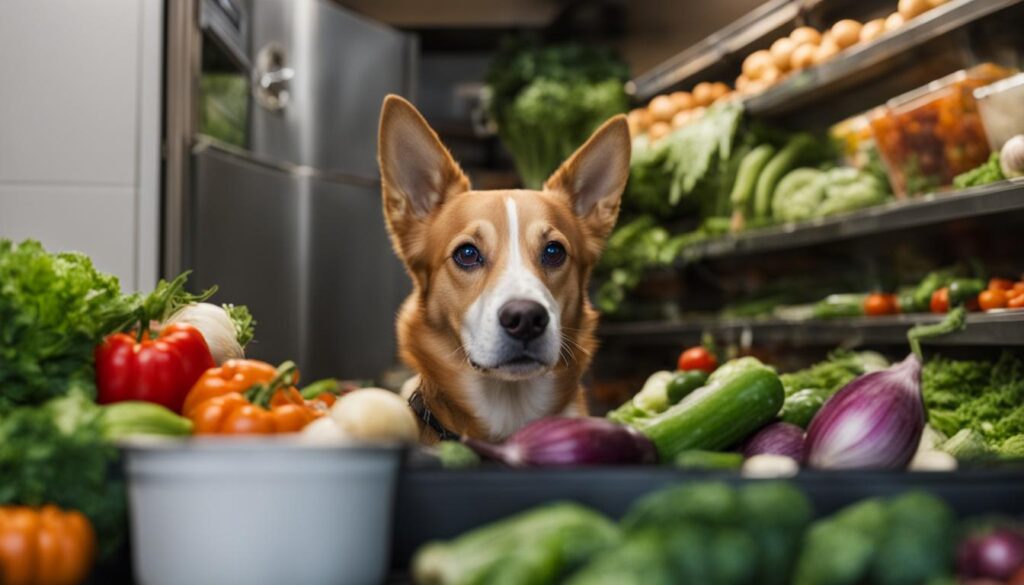
While vegetables can be a healthy addition to a dog’s diet, it is important to be aware of the vegetables that can be toxic and harmful to dogs. Some vegetables can cause gastrointestinal discomfort, damage to red blood cells, and even kidney failure in dogs. It is crucial to keep these vegetables out of reach of dogs and avoid feeding them any foods that contain these ingredients.
Alliums: Onions, garlic, leeks, and shallots are vegetables that should be avoided as they can cause gastrointestinal discomfort and damage dogs’ red blood cells if ingested. It is important to be cautious with any foods that contain these ingredients as well.
Grapes and Raisins: Grapes and raisins are highly toxic to dogs and can lead to kidney failure. Even small amounts can have serious consequences, so it is crucial to keep these fruits away from dogs at all times.
It is essential for dog owners to be aware of the potential dangers and toxicity of certain vegetables to ensure the safety and well-being of their furry companions.
Tips for Feeding Vegetables to Dogs
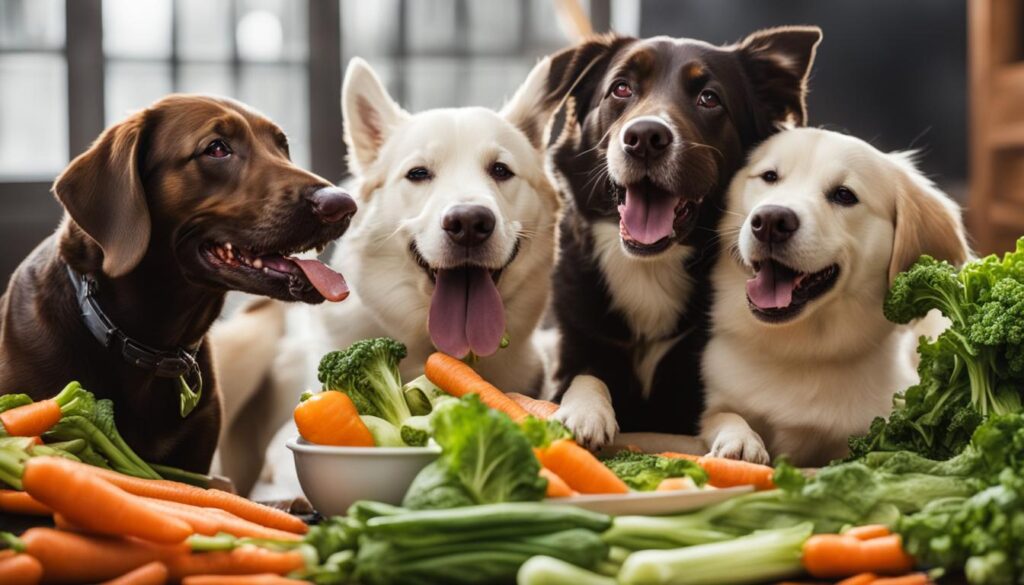
When it comes to incorporating vegetables into a dog’s diet, there are a few important tips to keep in mind. By following these guidelines, you can ensure that your furry friend receives the nutritional benefits of vegetables while minimizing any potential digestive issues.
- Introduce new vegetables gradually and in small quantities: Dogs may have different reactions to different vegetables, so it’s important to start with small amounts and observe how your dog responds. This gradual introduction allows their digestive system to adjust and minimizes the risk of upset stomachs.
- Avoid harmful ingredients: Some seasonings, spices, and additives can be toxic to dogs. When feeding vegetables, it’s best to avoid ingredients like butter, salt, and other seasonings that can be harmful to their health. Stick to feeding vegetables in their raw or cooked form without any additional ingredients.
- Monitor portion sizes: Just like with any other aspect of their diet, portion control is important when feeding vegetables to dogs. The amount of vegetables your dog needs will depend on their size, age, and individual dietary requirements. Consult with your veterinarian to determine the appropriate portion sizes for your dog.
It’s worth noting that not all vegetables are suitable for dogs, as some may be toxic or difficult for them to digest. Consulting with your veterinarian before making any changes to your dog’s diet is always a good idea. They can provide personalized advice based on your dog’s specific needs and help ensure a balanced and nutritious diet.
Quote:
“When incorporating vegetables into a dog’s diet, it’s important to consider their individual needs and preferences. Through gradual introduction and monitoring portions, you can safely incorporate these nutritious additions into their daily meals.” – Dr. Sarah Thompson, DVM
Incorporating Vegetables into a Dog’s Diet
Adding vegetables to a dog’s diet can be a beneficial way to provide them with essential nutrients and fiber. However, it is important to introduce vegetables gradually and in moderation to prevent any digestive issues. Just like us, every dog is unique, and their bodies may respond differently to certain vegetables. Consulting with a veterinarian can help determine the suitable types and amounts of vegetables to incorporate into your dog’s diet.
Dog-friendly vegetables like bok choy, lettuce, spinach, carrots, and squash can offer valuable vitamins and minerals. These vegetables can also promote healthy digestion and contribute to overall dog nutrition. When introducing new vegetables, it is crucial to closely observe your dog for any adverse reactions and make adjustments accordingly.
Remember that while vegetables are a great addition, they should never replace a high-quality and balanced dog food. Vegetables should be used as supplementary treats or additions to ensure that your dog’s nutritional needs are adequately met. A balanced and nutrient-dense dog food should remain the foundation of their diet.
FAQ
Can dogs eat bok choy?
Yes, bok choy is safe for dogs to eat in moderation. It can provide various health benefits due to its low-calorie and low-fat content, as well as its rich vitamins and minerals. However, it is important to introduce bok choy gradually and monitor your dog for any adverse reactions.
What other leafy greens can dogs eat?
Dogs can safely eat lettuce, spinach, chard, cabbage, and kale. These leafy greens are packed with nutrients like vitamins A, C, and K, and fiber. It is best to feed them in their raw form to ensure maximum nutritional benefits, but steaming or baking them can make them easier to digest for some dogs.
Are root vegetables safe for dogs?
Yes, root vegetables like carrots, beets, sweet potatoes, and parsnips are safe for dogs to consume. They are rich in nutrients and provide a good source of fiber. However, it is important to feed them in moderation due to their starchy and high-sugar nature.
Can dogs eat stalk vegetables?
Dogs can safely eat stalk vegetables such as celery and asparagus in small quantities. It is recommended to cut them into small pieces or steam them to make them easier to chew and digest. Stalk vegetables can provide additional fiber and nutrients to a dog’s diet.
Is squash safe for dogs to eat?
Yes, squash, including pumpkin and butternut squash, is safe for dogs to eat. It can be beneficial for dogs with digestive issues and is rich in nutrients while being low in calories. However, it is important to remove the seeds and skin before feeding it to dogs as they can pose a choking hazard.
Can dogs eat legumes?
Legumes like beans and peas can be safe for dogs to consume. However, it is important to avoid excessive amounts as recent reports have linked high legume diets to canine dilated cardiomyopathy (DCM). Green beans, although categorized as legumes, can be fed to dogs in moderation due to their taste and ease of digestion.
Which vegetables are toxic to dogs?
Vegetables such as onions, garlic, leeks, shallots, grapes, and raisins are toxic to dogs and should be avoided. These vegetables can cause gastrointestinal discomfort, damage to red blood cells, and even kidney failure in dogs.
What are the tips for feeding vegetables to dogs?
When feeding vegetables to dogs, introduce them gradually and in small quantities to avoid digestive upset. Avoid using butter, seasonings, or spices and feed vegetables raw or cooked without additional ingredients. Monitor portion sizes based on your dog’s size and individual tolerance, and consult with a veterinarian before making any changes to their diet.
How can I incorporate vegetables into my dog’s diet?
You can incorporate vegetables into your dog’s diet by adding them as supplemental treats or additions. Remember that a balanced and nutrient-dense dog food should still be the foundation of their diet. Work with your veterinarian to determine the appropriate types and amounts of vegetables to include in their meals.


